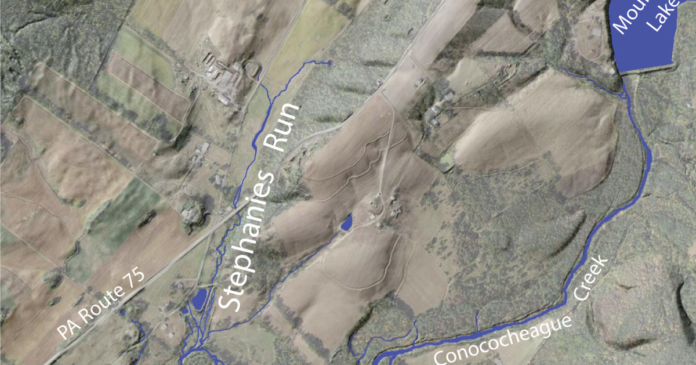Editor’s Note: This is a column on area watersheds by Blyden Potts and guest columnists to spread awareness of the area’s tributaries and the efforts of area volunteers to keep them clean.
I grew up in and near Harrisburg, but summers when I was an adolescent, I was relocated to Gramma Wood’s home in Path Valley, Franklin County, where my mother grew up. There, I was free to explore the woods and nature of the valley and mountains that contained the valley. That home, built by my Grandfather, by then deceased, was about a mile south of Fannettsburg.
At age four or five my Uncle Sam, who lived with Gramma, introduced me to fishing on the Conococheague, the creek that drains Path Valley. We would use worm balls, the worms having been collected from Gramma’s chicken yard. I still remember the garlicky, grassy smell of the Sunfish. Our poles were saplings, less the trimmed-off side branches, maybe 8 feet long.
The Creek was a quarter mile away. Closer by was a small spring-fed stream, or run. That run is of particular interest to me for at least three reasons: It was the source of drinking water for my Mother’s family for maybe 200 years; it had a special Brook Trout fishery; and is now named for my deceased sister, Stephanie.
Mother’s family got their drinking water from a cistern that collected rain water, or by toting from a spring about 100 yards distance. In 1940, when the Rural Electrification program brought electricity there, my father had a well drilled.
The spring feeds much of the flow of the run. It features a limestone retaining wall and access steps held together by gravity, built in the early 20th century. My grandfather is believed to have shaped the stone with such refinement that no mortar was required.
Only flowing one or two cubic feet per second, the run was a pleasure to behold, and a sensation to dip one’s feet into on a warm summer day. It had stretches of 20 inch depth and 20 inch width, with a gravelly bottom and undercut banks. Ideal habitat for trout.
It was home to a strain of Native Brook Trout, distinguishable from other strains in that there was no white bar on the pectoral fin. Otherwise just as lovely as a Brookie can be!
Every spring, White Suckers would run up from the Conococheague to spawn, so thick you could catch them by
hand.
Uncle Sam introduced me to fishing the run when I was six. I can remember Uncle Sam borrowing my new, highly-prized fly rod and baiting the hook with a fresh worm ball. When he got a bite, he’d separate the trout from the water by quickly jerking up. I can still see the butt of my delicate bamboo rod pointing straight up, the tip end straight down, trout-connected. After a second the hooked trout exploded up twenty feet in the air,
flying over our shoulder! Looking up, I could see a very-surprised Brook Trout looking down on us!
In my lifetime I’ve witnessed the physical demise of that Run, in bank destruction and trout habitat loss, caused, I suspect, by cattle activity. The unique native Brookies are gone, replaced by a few Brown Trout and Chubs.
My kid sister, Stephanie Freedman Parmer, loved to spend her summers in the area, with a friend whose family owned a farm on the run. In 1969, at age 25, Stephanie was a Shippensburg State College (now Shippensburg University) graduate and public school history teacher, when she was killed in a horseback riding accident.
It occurred to me that naming the run might be a fitting memorial to her. I learned the United States Geological
Survey (USGS) has a process to name geologic landmarks. After a few stumbles, I received notice on Feb.12, 2018, from the USGS that the hitherto unnamed tributary would receive the designation, “Stephanies Run.”
That is now its official name, which appears in stream databases and on recent maps.
*******
Gil Freedman is a retired Aerospace and Energy Engineer, and central Pennsylvania native who returned to the area. He is President of Conodoguinet Creek Watershed Association (CCWA), and has been for many years, where he has been very involved with stream conservation and restoration, and community education on water issues.
In his 80s, he lives in Silver Spring Township, and deals with Parkinson’s Disease.
Credit: Source link






























